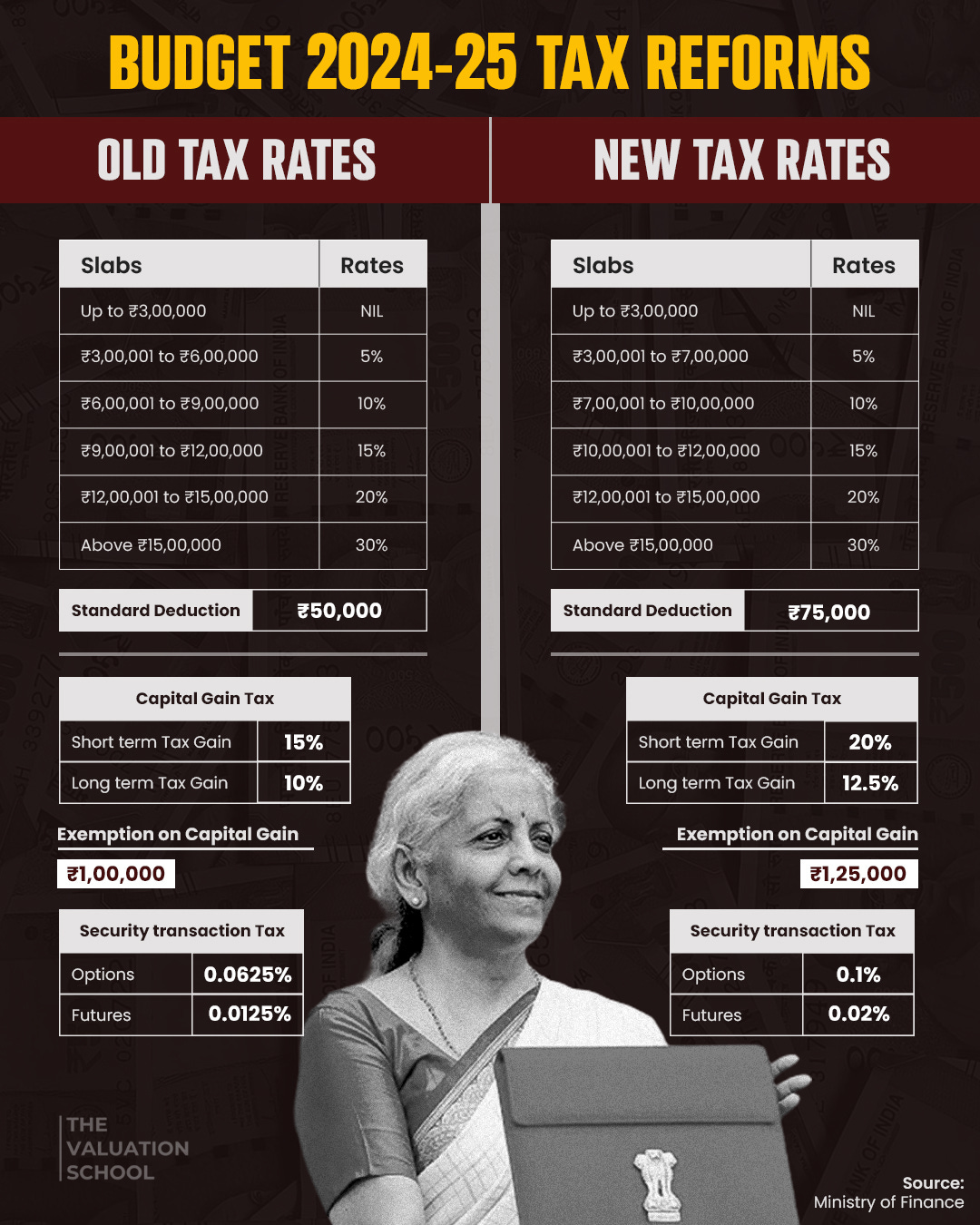Warren Buffett always felt it was wrong that he paid less in taxes than his secretary. In 2012, he suggested to the US government to increase the capital gains tax on investment income.
While the US government didn't take his advice, Nirmala Sitharaman seemed to listen. She presented the Union Budget on 23rd July, which surprised the entire nation.
Everyone expected this budget to be historic because it was the first budget after all the political drama during the elections for Modi 3.0 with the coalition government. But the budget seems to disappoint the nation's Aam Janta.
Market experts think this budget is one of the worst for not only Day traders but also for long-term investors.
So, in today’s newsletter, let’s closely examine the Union Budget 2024-25 and understand what valuable lessons we, as students of finance, can learn from it.
Roadmap to Vikshit Bharat.
‘Vikshit Bharat 2047’ is the current government’s roadmap to making India a completely developed nation by 2047.
This budget focused on four main groups:
'Garib' (Poor), 'Mahilayen' (Women), 'Yuva' (Youth), and 'Annadana' (Farmers).
It targets four main areas:
Employment, Skilling, MSMEs, and the Middle Class.
To illustrate how the government allocates its resources, the following infographic provides a clear view of revenue sources and expenditures.
A Look Back at India's Economic Cycles
In the past, from 1999 to 2002, India faced a banking crisis. Public sector banks had high levels of bad loans, known as gross non-performing assets (GNPAs).
By 2002, companies in India started to improve their balance sheets, leading to a strong market rally from 2003 to 2008. But in 2008, the Lehman Brothers crisis hit, causing banks to lend aggressively and support poor projects.
From 2008 to around 2012-2013, the situation worsened again with rising GNPAs. ICICI Bank and Axis Bank experienced issues, prompting the Reserve Bank of India (RBI) to step in.
By 2013, the stock market valuations became cheap, leading to another market rally until 2017-2018, which ended due to the IL&FS crisis. From 2018-2019, the markets remained flat, and then COVID-19 struck in 2020.
Since 2021, a new credit cycle began. Companies cleaned up their balance sheets. From November 2021, the markets peaked but then moved sideways until March 2023.
India's economy has grown a lot over the years. In the 1970s, the average growth rate was about 4.4%. Recently, it has increased to more than 7%. This growth comes from a strong mix of agriculture, industry, and services.
India has also been good at handling tough times. For example, when the government Implemented demonetization and introduced a new Indirect tax system (GST), the economy slowed down for a bit but quickly recovered.
These efforts are helping India move towards becoming a USD 7 trillion economy by 2030.
Current Recovery Driven by Government Capex
Now, the recovery is driven by government spending on infrastructure (capex) rather than private investment. The sectors benefiting from this cycle include power, railways, renewable energy, metals and mining, and electronic contract manufacturing. These sectors have been boosted by various government initiatives.
Although the government has allocated funds to these sectors, it hasn't provided much detail about the roadmap for the coming years. There is little clarity and planning on the next steps. This lack of information has worried people, as they are looking for clear strategies and timelines.
The budget has mentioned capex allocations for these sectors, but specific plans are still unclear.
Here are some key allocations to sectors from the Budget:
Infrastructure: In the near term, infrastructure companies will benefit from the capex push. For instance, the government has allocated Rs. 11,11,111 crore for capital expenditure, which is 3.4% of the GDP.
Automobile Components: Production-linked incentive schemes for automobile components have seen a year-on-year increase of 6.24%.
Renewable Energy: The allocation for the solar power grid has increased by 110%, while the allocation for wind energy has decreased by 10-15%.
Defense: The defense sector has received 12.9% of the total budget allocation, with a capital outlay of ₹1.72 lakh crores, up from ₹1.27 lakh crores last year. Domestic procurement stands at ₹1.05 lakh crores, benefiting defense companies.
Telecom: The telecom sector has been allocated ₹1.29 lakh crores, with a significant portion for BSNL. The BharatNet program and increased production-linked incentive schemes for telecom equipment show a positive trend.
Railways: The railway sector's total allocation is ₹2.50 lakh crores. However, the growth rate has slowed to 5% this year, with a significant focus on safety due to frequent railway accidents.
Major Changes in the Budget:
1. Changes in taxes:
The Valuation School team has created a very informative and easy-to-understand infographic about changes in taxes.
2. No Indexation benefit:
One significant change that will impact the real estate market is the removal of indexation benefits when selling real estate.
Indexation is a broad topic, but let me explain it in simple terms so you can understand how this will affect real estate investments.
What is Indexation?
In simple language, Indexation adjusts the purchase price of your property for inflation.
This means it takes into account how the value of money changes over time. Doing this reduces the capital gains tax you have to pay.
Why is Indexation Important?
When you sell a property, the profit you make is called a capital gain. Indexation helps lower this gain and results in lower taxes.
How Does It Work?
Let's look at a simple example:
Purchase of Property: Imagine you bought a house in 2010 for ₹10,00,000.
Selling the Property: Now, in 2023, you sold the house for ₹30,00,000.
Capital Gain Without Indexation:
Capital Gain=Selling Price−Purchase Price
=₹30,00,000−₹10,00,000
=₹20,00,000Without indexation, your taxable gain for the year 23-24 is ₹20,00,000.
Applying Indexation:
The government provides a Cost Inflation Index (CII) each year.
You can check all the CIIs for each year using this link.CII for 2010 = 167
CII for 2023 = 348
Using the formula to find the Indexed Cost of Acquisition:
Indexed Cost of Acquisition = Purchase Price×(CII in the year of sale/CII in the year ofpurchase)
Plugging in the values:
Indexed Cost of Acquisition=₹10,00,000×(348/167)
=₹20,83,832Recalculate Capital Gain With Indexation:
Capital Gain=Selling Price−Indexed Cost of Acquisition
=₹30,00,000−₹20,83,832
≈₹9,16,168With indexation, your taxable gain is reduced to ₹9,16,168.
Calculating the Tax Payable:
Without Indexation:
New Tax Rate: 12.5%
Tax Payable=Taxable Gain×Tax Rate
= ₹20,00,000 × 12.5% = ₹2,50,000.With Indexation:
Old Tax Rate: 20%
Tax Payable=Taxable Gain×Tax Rate
= ₹9,16,168 × 20% = ₹1,83,234.
So in conclusion when you were getting the indexation benefit, your taxable capital gain was reduced to approximately ₹9,16,168, resulting in a tax payable of ₹1,83,234. Without indexation, your taxable gain is ₹20,00,000, leading to a higher tax payable of ₹2,50,000.
Hence, with indexation, you save ₹66,766 in taxes.
3. Custom Duty
Precious Metals: Gold, Silver, and Platinum
Gold and Silver: The import duty on gold and silver has been reduced from 15% to 6%. This reduction is expected to make gold and silver jewelry more affordable and increase demand in the domestic market.
Platinum: The import duty on platinum has been reduced from 15.4% to 6.4%. This change will also lower the cost of platinum jewelry for consumers.
The reason behind the changes:
Lower import duties will reduce jewelry prices, making them more affordable.
Increased demand for gold, silver, and platinum jewelry is expected to create more jobs for artisans and workers in the jewelry industry.
High import duties often lead to increased smuggling of precious metals. The reduction in duties is expected to curb illegal activities and support the organized retail gold trade, enhancing government revenue.
Critical Minerals
Waived Duties: Import duties ranging from 2.5% to 10% have been waived on 26 critical minerals.
Reduced Duties: Duties on two minerals have been reduced from 5%-7.5% to 2.5%.
What Are Critical Minerals?
Critical minerals such as lithium, cobalt, nickel, tin, graphite, tungsten, and copper are essential for modern technology and renewable energy. These minerals are used in the production of solar panels, semiconductors, wind turbines, and advanced batteries.
The reason behind the changes:
Lower import duties on critical minerals will make it cheaper to produce renewable energy technologies, supporting India’s goal of achieving net-zero emissions.
The duty reductions will also encourage the development of domestic processing facilities, which are crucial for handling these minerals.
Industrial Inputs
Components for Electronics and Machinery: Import duties on several components used in electronics and machinery manufacturing have been reduced. This aims to lower the cost of production for domestic manufacturers and boost the competitiveness of Indian products in global markets.
The reason behind the changes:
Lowering the import duties on essential components will reduce the cost of production for manufacturers, leading to cheaper end products for consumers.
These changes are part of the government’s broader strategy to promote domestic manufacturing under the ‘Make in India’ initiative.
Impact on the Market:
After the Finance Minister announced an increase in Long-Term Capital Gains (LTCG) and Short-Term Capital Gains (STCG) taxes, the market reacted quickly. Although these tax changes might seem small to the government, they had an immediate impact on the market.
The market declined significantly. The NSE Nifty 50 and S&P BSE Sensex both dropped about 1% each. The Indian rupee also hit a record low against the US dollar, reaching 83.69.
Despite the initial drop, the market started to recover within 10 minutes.
Possible Reasons for Quick Recovery:
Mutual fund houses, holding a large amount of cash, had to deploy money into the market.
Retail investors saw an opportunity to buy stocks at lower prices or a discount, contributing to the market rebound.
My opinion:
On budget day, I went live on YouTube to share some of my opinions and insights on the budget.
Resources:
Union Budget 2024-25 serves a strategic blueprint for Viksit Bharat.
Union Budget 2024: Five problems with Indian economy and how they could be addressed.
How Union Budget 2024 will impact the health sector.
How your SIPs will be taxed after capital gains rate changes.
Don’t let rings be run around the budget deficit.
Final Thoughts:
The budget wasn’t what we hoped for, and it doesn't seem to favor long-term investing. But does this mean we should stop looking for good value companies?
Absolutely not! Even with the changes in taxes, stocks are still the best way to build wealth if you choose high-quality businesses and stay invested for a long time.
As finance students who want a career in equity research, our main job is to work hard to find good stocks for ourselves and our clients.
Remember that people will eventually get used to the new tax rates but our goal shouldn’t change.
I'll end this newsletter with my favorite meme about the budget from the internet.
We hope you enjoyed this edition of our case study series and that it’s adding value to your life.
Let me know in the comments what you think about the budget or just share your favorite meme.
This is Parth Verma,
Signing off.









The budget did disappoint us but your newsletter didn’t. Well researched and explained aptly
Indexation concept explained very well.